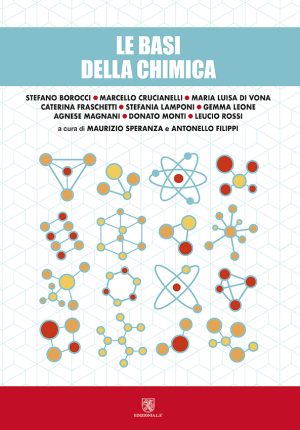- Se hai domande:
- 06 43597938
- +39 3450714376
- info@edizioniale.it

Il Cervello Inconscio -Ediz. Italiana a Cura di Enrico Cherubini
Marzo 14, 2025
Quando il grano maturò – Storie di gente r-esistente M. Sacerdote
Marzo 14, 2025Chemistry and Introductory Biochemistry
€58,00 Original price was: €58,00.€52,00Current price is: €52,00.
This textbook of Chemistry and Introductory Biochemistry, authored by Mauro Maccarrone, Carmine Di Ilio, Giovanni Fasciaglione, Osvaldo Lanzalunga, Giuseppina Nocca, and Maurizio Speranza, represents a valid support for the homonymous half-yearly course of the Master’ degrees of bio-medical orientation, such as Medicine and Surgery, Dentistry and Dental Prosthetics, Biomedical Laboratory Techniques, Exercise, Sports and Health Sciences, Nursing, and others.
The authors of the present text stand out for their intense research and teaching activities in Chemistry and Biochemistry assisted by some colleagues and collaborators, whose names are reported on the cover of the book. Maurizio Speranza is a Professor Emeritus of General and Inorganic Chemistry, Osvaldo Lanzalunga is a Full Professor of Organic Chemistry, Carmine Di Ilio and Mauro Maccarrone are Full Professors of Biochemistry, as well as Professor Giuseppina Nocca and Doctor Giovanni Fasciaglione who are distinguished scientists and teachers in the field of Biological Chemistry. Aided by their considerable experience, the authors have designed this textbook with the intention of satisfying two conflicting needs. On the one hand, the need to reduce and simplify, as far as possible and desirable, the program to be offered to students in the short time frame allowed to the course. On the other hand, the need to explain, with clarity of exposition and absolute rigor, those concepts of General Chemistry and Organic Chemistry that are indispensable for a correct and harmonious learning of Biochemistry.
The text consists of 19 chapters and 4 appendices (Symbology of the physical quantities used in the text; Fundamental and derived quantities and their units of measurement in the International System; Conversion table of units of measurement of physical quantities; Main Physical Constants). Following tradition, the 19 chapters of the book are divided into three sections: 10 in the first section of General Chemistry which illustrates the fundamental laws of chemistry; 4 in the second section of Organic Chemistry which describes the structural characteristics of important families of organic molecules, their chemical-physical properties and their reactivity; 5 in the last section of Biomolecules which deals with the structure of some categories of biomolecules and their function in some biological processes. The three parts are intimately interconnected to give an overview of these ever-evolving disciplines. The authors have put a lot of effort into the choice of the contents to be introduced in the book, explaining them in a simple and rigorous way, often condensed in tabular form. All this, to provide the students a handy, fluent and, at the same time, complete text and to teachers a quantity of material from which to select the topics to be covered. The cultural path, proposed in the text, is the essential part of the exam of Chemistry and Introductory Biochemistry. It is flanked by 22 Addendum Sections that the student could and, in some cases, should consult to complete and deepen the concepts learned in the text. Similarly, 22 Application Sections have been included that the aim of pointing out to the student how the fundamentals of chemistry impact on the processes of formation of many biomolecules, on their structure, and on their transformation in many biological cycles. In addition, the authors have provided the student with extensive examples in the text so that he can immediately verify his understanding of the fundamental concepts of Chemistry and basic Biochemistry. In the same perspective, about a hundred exercises have been included in the text. At the end of each chapter, summary sheets have been inserted to offer the student a quick review of the concepts and reactions studied. In conclusion, the right balance between rigor, completeness, and simplicity of exposition makes this text of Chemistry and Introductory Biochemistry an indispensable tool for the student in his training in the bio-medical field. It is hoped that, through this support, he will be able to equip himself with a rational framework of this discipline and a knowledge that goes beyond passing the exam.
Bruno Botta
Related products
-
Offerta – Le basi della chimica – Stechiometria – Esame di chimica generale
€97,50Original price was: €97,50.€92,60Current price is: €92,60. -
Le basi della Chimica
€58,00Original price was: €58,00.€55,10Current price is: €55,10. -
Prove di esame di chimica generale
€33,00Original price was: €33,00.€31,35Current price is: €31,35.





